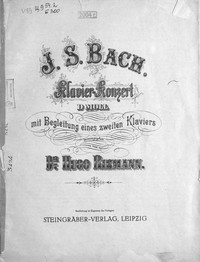Бах, И.C. - Klavier-Konzert D-moll mit Begleitung eines zweiten Klaviers [Ноты]
Бесплатно
Основная коллекция
Тематика:
Нотные издания
Издательство:
Год издания: 2016
Кол-во страниц: 38
Дополнительно
Вид издания:
Ноты
Артикул: 642963.01.99
Тематика:
ББК:
УДК:
ОКСО:
- 53.00.00: МУЗЫКАЛЬНОЕ ИСКУССТВО
- ВО - Бакалавриат
- 53.03.01: Музыкальное искусство эстрады
- 53.03.02: Музыкально-инструментальное искусство
- 53.03.03: Вокальное искусство
- 53.03.05: Дирижирование
- 53.03.06: Музыкознание и музыкально-прикладное искусство
- ВО - Магистратура
- 53.04.01: Музыкально-инструментальное искусство
- 53.04.04: Дирижирование
- ВО - Специалитет
- 53.05.02: Художественное руководство симфоническим оркестром и академическим хором
ГРНТИ:
Скопировать запись
Фрагмент текстового слоя документа размещен для индексирующих роботов
;д : ..А Л Ь UАЯ библиотека
Bearbeitung ist Eigentum des VeHegers
STEINGRABER-VERLAG, LEIPZIG
Zur Erlauterung der Phrasierungsbezeichnung.
Die den Ta ktstr ich e n untergeschriebenen Zah-l e n legen den thernatischen Aufbau im Grossen dar d. h. weisen die Perioden-Gliederung auf, sind eine dnrchgefiihrte musikalisehe Tnterpunktion: die <9 zeigt das Ende der Periode an, ent-spricht also ungefahr dem Puhkt der Schriitsprache; die 4 steht ahn-lich zum Kolon Oder Semikolon in Parallele; die 2 isl meist, die 6 wohl inimer dem Komina zu vergleichen. Ubrigens sind aber die Zah-len nichts welter als die Ordnungszahlen der Takte innerhalb der ein-zelnen Perioden. Wo rhythmische Komplikationen gar nicht vorkommen, laufen sie regelmassig von /bis <? und beginnen nach 8 wieder mit /. Alle Anfange ex abrupto, Einschaltungen, Auslassungen, Dehnungen , brangungen und Verschrankungen (Umdeutungen des Endes zum neuen Antang u. dergl.j sind durch die Z&hlen sofort verstandlich auszudriik-ken und bediirfen keiner weitersn Erlauterungen dutch besondere An-merkungen. Вет punktierte Taktstrich ist entweder ein aufgehobe-ner Taktstrich (eine schwere Zeit wird leicht> Oder aber ein wie-derholter (eine leichto Zeit wird schwer)-, dos geklammerte Zeichen' des schweren Takts (y) hat ahnlichen Sinn (Umdeutung des schweren Takts zum leichten Takt. iiberm punktierten Taktstrich sogar Umdeu-tung zum leichten HaTbtakt).
Fiir die Gliederung im Kleinen (Bestimmung der Motivgrenzen) ist das Leeezeichen (• resp.¹¹) angewandt; alle andoren Zeichen (Lega-tobb'gen Punkte, Strichpunkte) shidim gemeiniiblichen Sinne beibehal-ten, nur mit strengerer Kritik durchgefiihrt. Das л bedeutet nicht ei-nen dynaroischen Accent (Drucker), sondern einen ago g i schen Accent (gelinde Dehnung des Notenwerts).
EXPLANATION OF THE SIGNS OF PHRASING.
The numbers written below the bars make clear the broad features qf the thematic structure, i.e., show its articulation in periods, they cere a systematically applied musicaljmnctuation: the 8 indicates the close of the period, consequently nearly oorresptmds to the full slop of the written language -, the 4 is used like the co, Ion or semicolon in parallels; the 2 is mostly, the 6 perhaps always, comparable to the comma. However, the numbers are nothing more than the ordinal numbers of the bars within the several periods Where rhythmical complications do not occur, they run regularly from 1 to 8 and begin qfl&r 8 again with 1. All beginnings ex abrupto, intercalations, omissions, expansions, contractions, and dove-tailings (the close becoming the new beginning and the like) can be expressed at once intelligibly by the numbers and do not need any further explanations by means qf special annotations. The dotted bar is either a suppressed bar(where an accented lime becomes unaccented)or a repeated bar (where an unaccented time becomes accented)) the sign im parenthesis of the accented bar (v) has a similar meaning (change of the accented bar to the unaccented, above the dotted bar even change to the unaccented half-bar).
For the articulation in detail {fixing of the limits of the motives') the reading-sign (¹ respectively¹¹) is employed; all other signs (slurs, dots, dots and dashes) retain their usual meaning, only have been used with greater critical strictness. The ~ signifies not a dynamic accent (emphasis), 'but ah agogic accent (slight expansion of the value of the note).
EXPLICATION EES SIGNES EES EDITIONS PHEA SEES.
Les chiffres sanserifs aux barres de mesure demontrentles traces de la. construction thematique, e’est a dire.ils font voir I'en-charnement et la structure interne des period.es et representent tone complete ponotuatten- grammaticale pour la musigue-. le 8 in-dique la fin diene periode en sorte qu’il repand aupoint grammatical; le 4- se trouve analogiquement en parallele avec le colon (deux points) ou le semicolon (point et virgule); le 2 est a comparer le plus souvent, le 6 pent-etre partout au comma (virgule). Du reste les chiffres ne sont autre chose que des nombres ordinals des mesures au dedans des singles p emo des. Oil il ri у a pas de complications rhytteraques, Us marchent reguherement de la 8, ei apres recommencent a 1. Tous les commencements ex abrupto, les reiterations, les elisions, dilatations, contractions et ent rdace-ments (remplaxements d'tine termination par un nouveau commencement etc.) s'exprunent de suite indubitablemerntpar les chiffres
et n'exigent point d’autre explication par des notes speciales. fa barre pointillee se presents comme barre annullee (quand un temps grave [for^ deviant anacraustique (faible) ou comme barre reiteree (quand une anacrouse devient temps grave); le. signs de la mesure grave paranthese A) est dien semblable sens (changement de mesure grave en mesure anaoroustrique, et quand U se trouve SUr la barre pointillee meme en temps anacroustique).
Pour Г exhibition des details de la ponctuation (e’est a dire la precision de Vet endue des motifs) s'emploie le guide (' ou *'); tous les autres signes (c 'est ceux pour le legato, staccato, portaio) ont ete conserve en leur comnvun sens, seulement ipt'ils aient die appliques avec-une critique plus severe. Le a. ne signifie pas un accent dynarnique (renforcement), mate plutof un accent agogi-que (prolongement modique de la duree).
Dr. Hugo Riemann.
Чит. зал
J. S. BACH.
KLAVIER-KONZERT Dmoll.
Edition Steingraber.
456
456 Edition Steingraber.
Edition SteingrSlber. 46»
Edition Steingraber. 45b
.9 Edition Steingriber. 456
Edition Stelngraber. 456
Edition Steingraber. 458

